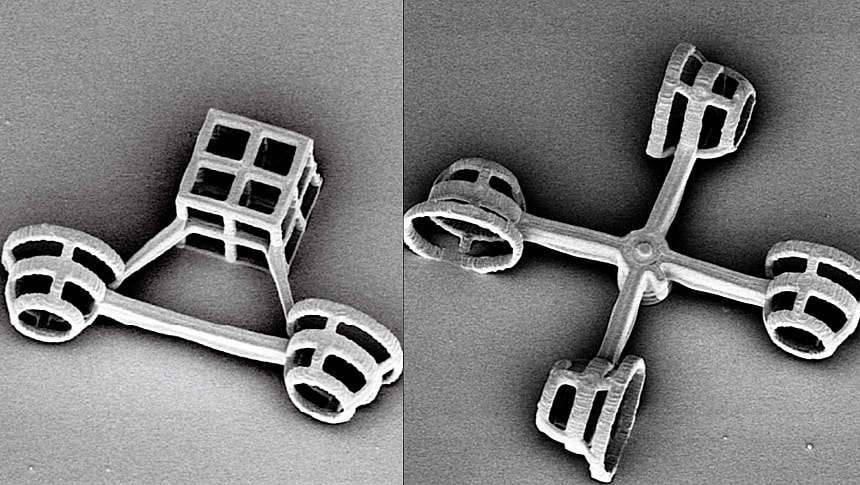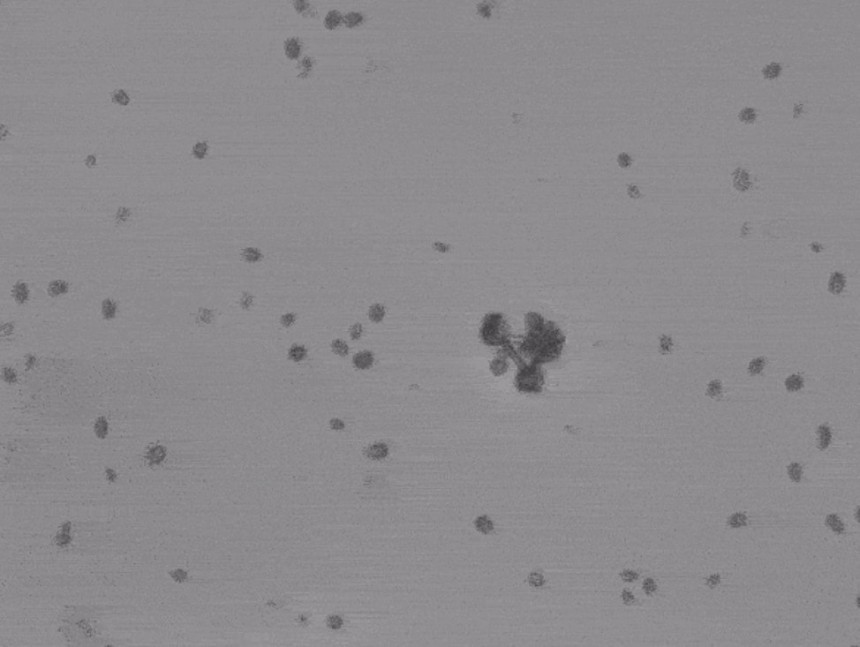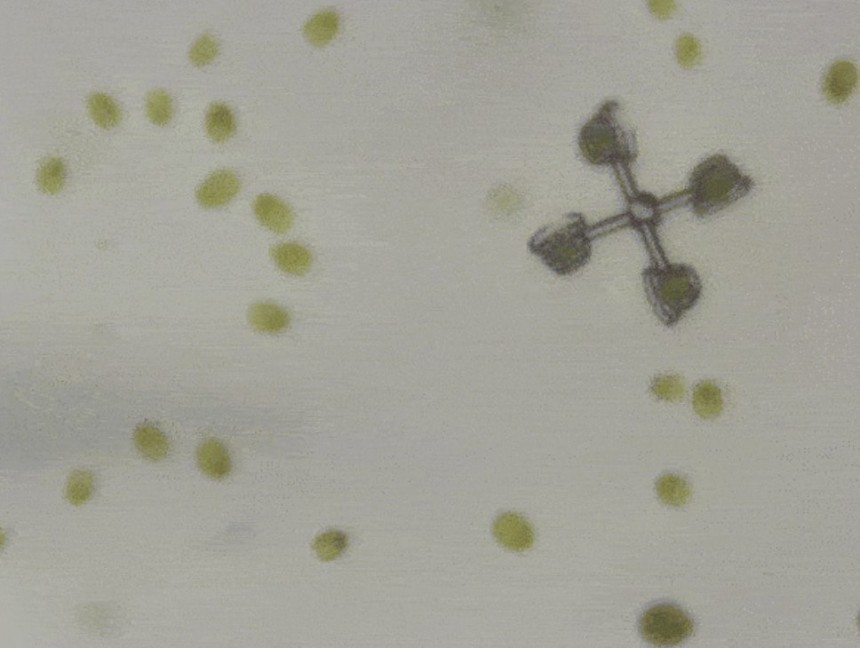If you don't mind stretching things a bit, a horse or any other animal used to pull human-made vehicles is a sort of living engine. Our species has been using them forever, and we still do, despite having machines at our disposal that can propel themselves through various means. But what about microscopic living engines meant to power things too small to see?
There is a need in some circles to create microscopic machines that can be used for a variety of purposes, from medicine to computing. For a while now, people have been trying to convince stuff like bacteria, proteins, or even sperm cells to pull microscopic objects behind them, effectively turning them into the horses of the miniature world.
Success in this field doesn't come easily, but from time to time something interesting enough to catch our attention does happen. Like, say, convincing a type of algae called Chlamydomonas Reinhardtii to move two human-made structures called Scooter and Rotator.
The experiment was conducted by a team from the University of Tokyo, led by Graduate School of Information Science and Technology student Naoto Shimizu. It was designed based on the innate locomotion abilities microorganisms have.
Chlamydomonas Reinhardtii is a single-cell green alga that can be abundantly found all over the world. It's not spectacular in any way, except perhaps thanks to the fact that examples of it are now domesticated in some sense.
You see, the stuff is motile, meaning it is capable of motion, like a lot of other microorganisms out there. So what if we could convince a bunch of these algae to put on a harness and move stuff this or that way?
The Japanese team answered that question by constructing two microscopic vehicles, one called Scooter and the other Rotator. It's unclear how they were made, but we do know the former is more or less a cubic box, while the latter comes as four sticks that come together in a central hub to form a sort of four-spoke design.
Both structures were gifted with so-called traps that make one device look like a water scooter and the other like a watermill. These traps are essentially baskets fitted with multiple shrinking rings. They were meant to contain the Chlamydomonas Reinhardtii so that when trying to move in their medium by using their forward-stretching flagella, they would push against the trap, moving the entire structure in the process.
The Scooter design was equipped with two such traps, both of them facing in the same direction. In this case scientists found evidence of something that's pretty commonsense: it's almost impossible to convince separate alga cells to work together for a common goal, so instead of moving forward, the Scooter ended up performing yaw, pitch, and roll movements.
The Rotator, on the other hand, had four traps placed in such a way as to form a circular pattern. In this case, the cells somehow agreed on what to do, and that meant the structure moved in a smooth, controlled rotational fashion. On top of it all, the thing is 56 microns in diameter, five times larger than what similar experiments managed to move with bacteria.
For the purposes of the experiment, the team used no less than 14 traps. Observations on the movement of the algae was performed over a period of 15 minutes, captured and recorded at a frame rate of 15 fps. To keep an eye on the trajectory of the minuscule objects, specialized software was used.
What did this experiment reveal in the end? First up, it is now obvious that the otherwise random movement of microscopic elements can be given a sense of purpose by carefully configuring and placing the traps.
Then, if one wants to move something bigger (but still microscopic) or faster, the simplest solution is to employ a larger number of organisms.
A lot of research lies ahead in this field, but it is possible that one day we'll have application-oriented biohybrid micromachines that are capable of moving about with no external influence the likes of magnetic or electrical fields.
These things could be successfully used in biological and environmental research, but if you really think about it, the possibilities are literally endless. In the end, such devices could be a lot more effective than engineered engines of this size.
The Japanese scientists now call on the development of "a mechanism for multiple organisms to effectively cooperate as the driving force of the micromachine." To get there, the team plans to conduct some more experiments, including one where they intend to increase the arrangement of the trap structure to achieve more precise direction control.
You can have a complete look at the experiment on Chlamydomonas Reinhardtii as microscopic engine by going through the official paper, published in the Wiley Online Library's Small publication. Beware, though, it's pretty long and technical.
Success in this field doesn't come easily, but from time to time something interesting enough to catch our attention does happen. Like, say, convincing a type of algae called Chlamydomonas Reinhardtii to move two human-made structures called Scooter and Rotator.
The experiment was conducted by a team from the University of Tokyo, led by Graduate School of Information Science and Technology student Naoto Shimizu. It was designed based on the innate locomotion abilities microorganisms have.
Chlamydomonas Reinhardtii is a single-cell green alga that can be abundantly found all over the world. It's not spectacular in any way, except perhaps thanks to the fact that examples of it are now domesticated in some sense.
You see, the stuff is motile, meaning it is capable of motion, like a lot of other microorganisms out there. So what if we could convince a bunch of these algae to put on a harness and move stuff this or that way?
Both structures were gifted with so-called traps that make one device look like a water scooter and the other like a watermill. These traps are essentially baskets fitted with multiple shrinking rings. They were meant to contain the Chlamydomonas Reinhardtii so that when trying to move in their medium by using their forward-stretching flagella, they would push against the trap, moving the entire structure in the process.
The Scooter design was equipped with two such traps, both of them facing in the same direction. In this case scientists found evidence of something that's pretty commonsense: it's almost impossible to convince separate alga cells to work together for a common goal, so instead of moving forward, the Scooter ended up performing yaw, pitch, and roll movements.
The Rotator, on the other hand, had four traps placed in such a way as to form a circular pattern. In this case, the cells somehow agreed on what to do, and that meant the structure moved in a smooth, controlled rotational fashion. On top of it all, the thing is 56 microns in diameter, five times larger than what similar experiments managed to move with bacteria.
For the purposes of the experiment, the team used no less than 14 traps. Observations on the movement of the algae was performed over a period of 15 minutes, captured and recorded at a frame rate of 15 fps. To keep an eye on the trajectory of the minuscule objects, specialized software was used.
What did this experiment reveal in the end? First up, it is now obvious that the otherwise random movement of microscopic elements can be given a sense of purpose by carefully configuring and placing the traps.
A lot of research lies ahead in this field, but it is possible that one day we'll have application-oriented biohybrid micromachines that are capable of moving about with no external influence the likes of magnetic or electrical fields.
These things could be successfully used in biological and environmental research, but if you really think about it, the possibilities are literally endless. In the end, such devices could be a lot more effective than engineered engines of this size.
The Japanese scientists now call on the development of "a mechanism for multiple organisms to effectively cooperate as the driving force of the micromachine." To get there, the team plans to conduct some more experiments, including one where they intend to increase the arrangement of the trap structure to achieve more precise direction control.
You can have a complete look at the experiment on Chlamydomonas Reinhardtii as microscopic engine by going through the official paper, published in the Wiley Online Library's Small publication. Beware, though, it's pretty long and technical.








